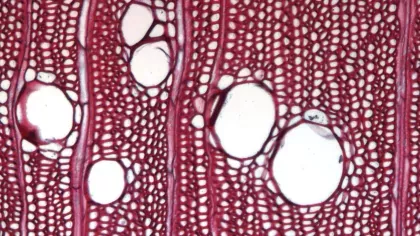24 September 2016
Names matter: trade of threatened medicinal plants
Find out why plant names pose practical problems for the regulation of international trade in medicinal plants, and what the Medicinal Plant Names Service (MPNS) are doing to help.

Introduction to the trade in medicinal plants
When the CITES (Convention on International Trade in Endangered Species of Wild Fauna and Flora) team based at Kew attended the 17th Conference of the Parties (CoP17) in autumn 2014, the MPNS was highlighted as a valuable reference for facilitating effective regulation of the trade in medicinal plants.
The trade in medicinal plants is notoriously difficult to quantify and track, yet it has considerable economic significance and is growing rapidly. Unfortunately, little reliable research exists on the scale of trade in particular species; one challenge being the alternative ways plants are labelled or otherwise referred to.
Increasing demands for certain species can lead to unsustainable harvesting which impacts negatively on local ecosystems. The CoP17 discussed several proposals to add new species to CITES listings due to the risk of over harvesting to meet the demand for herbal medicines. One example was a proposal by South Africa to include Siphonochilus aethiopicus (Schweinf.) B.L.Burtt (natal ginger or wild ginger) on CITES Appendix II.
This would require anyone wanting to export this plant or products made from it to obtain a permit demonstrating that trade will not be detrimental to the survival of the species in the wild. As the root and rhizome are used this species is particularly susceptible to over harvesting. It is traditionally used to treat malaria, headaches, colds, asthma, and other illnesses. Due to its medicinal use this species has become Critically Endangered in South Africa and Endangered in Swaziland. It is also threatened in several other Southern African countries.
Trade and names
CITES listings use an agreed set of names, for scientific and legal reasons. In the trade, however, a wide range of different names are used interchangeably, and often with imprecise and overlapping meanings. Navigating between the names used in practice, and the regulated species names can be problematic and complicated.
Using scientific names appropriately offers its own challenges, for example, names change over time, as taxonomists come to better understand the relationships between species. Across disciplines and country boundaries different scientific names (synonyms) are used to refer to the same species. More alarmingly, in around 4 per cent of cases, Latin binomials can be ambiguous: the same name given to different species, having been published by different authors (homonyms).
Plant products are commonly labelled with non-scientific names, creating complications for border control officers. Common names are problematic as they can refer to multiple species from different places. The name ‘ginseng’, for example, has been used to refer to at least 12 different species of plant used medicinally, two of which are listed on CITES: Panax quinquefolius L. and Panax ginseng C.A.Mey (only populations in the Russian Federation). Border officials can often be faced with products entering a country labelled with a name in any language, and of course unscrupulous traders will even deliberately mislabel a product or invent a name to avoid detection.
Kew’s Medicinal Plant Names Services
The MPNS was created to facilitate effective communication about medicinal plants. We collate names for medicinal plants as they are published, both in trade and in medicinal plant regulations and references, which are then linked to Kew’s global taxonomic resources.
The MPNS resource currently covers approximately 14,000 species. Of these, nearly 21,000 different scientific names and 47,000 non-scientific names have been used in the medicinal plant literature. MPNS connects these names to Kew’s taxonomic resources, which include over 212,000 scientific names for the same set of plants.
The MPNS portal can be searched using any category of name and will produce a list of all plants associated with that term, as well as:
- scientific name
- synonyms
- published in medicinal plant references
- non-scientific names (and plant parts)
We release new versions of the MPNS resource on a quarterly basis, to reflect both enhancements in taxonomy, and additional names collated from new medicinal references. MPNS is formally versioned and a summary of changes between versions is made available. As each published version is static MPNS may in the future be used as the Standard Reference for medicinal plants.
Using MPNS to decipher confusing names
One case reported to us involved a company importing products from South Africa into the UK, labelled as containing ‘Aloe capensis’. Although this name may look like a scientific name (because it is written in Latin) it is a pharmaceutical name used in pharmacopoeias (publications of medicinal drugs) to define a particular medicinal preparation. Such definitions establish which part of the plant is used and how to prepare the medication, but can be surprisingly imprecise in their use of scientific names. The name may refer to more than one species, and another pharmacopoeia may use exactly the same term to refer to quite different plants.
The MPNS portal detects that the name ‘aloe capensis’ is a pharmaceutical name which may refer to herbal substances derived from either Aloe vera (L.) Burm.f. and/or Aloe ferox Miller. The problem for border control officers was that Aloe ferox Miller is included on Appendix II of CITES, and thus requires an export permit. Aloe vera (L.) Burm.f. on the other hand requires no such permit. Since it was not clear which species the product contained, the shipment was withheld and its sale prevented. This could have been avoided if the scientific name was included on the packaging.
MPNS and CITES status
The MPNS portal doesn’t currently display the CITES status of each species contained. Our ambition is for such information to be displayed in the future and for MPNS to link to other resources such as Species+ (an online resource for CITES listings), in addition to the medicinal resources that MPNS already points to.
Recognition of the value of MPNS to CITES illustrates how we are making Kew’s taxonomic data more accessible to new audiences. The MPNS portal is already widely used by those producing herbal products, importing plant materials, monitoring adverse health events, undertaking phytochemical and pharmacology research, and health practitioners. Health regulators such as FDA and WHO also rely on MPNS to improve the accuracy of herbal medicine regulation.
We aim to build on this success to further assist the work of CITES regulation, and to help in a small way toward ensuring wild populations of medicinal plants are protected for future generations.


